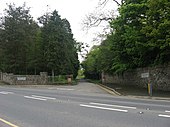Mellifont Abbey
| Mellifont Cistercian Abbey | |
|---|---|
 Model of the old abbey |
|
| location | Mellifont, County Louth, Ireland |
| Lies in the diocese | Archdiocese of Armagh |
| Coordinates: | 53 ° 44 '32.3 " N , 6 ° 27' 59.3" W |
| Serial number according to Janauschek |
173 |
| founding year | 1142 |
| Year of dissolution / annulment |
1539 |
| Year of repopulation | 1938 (Trappist) |
| Mother monastery | Clairvaux Monastery |
| Primary Abbey | Clairvaux Monastery |
| Congregation | (Trappists) |
|
Daughter monasteries |
Monasteranenagh Abbey |
Mellifont Abbey ( Irish : An Mhainistir Mhór , "the great monastery" ; Latin : Fons Mellis , translated: "honey spring" ) is the oldest Cistercian abbey in Ireland .
The old abbey
The abbey was founded in 1142 on the initiative of Archbishop Malachias von Armagh and Bernhard von Clairvaux as a subsidiary of Clairvaux Monastery in Mellifont in County Louth on the banks of the Mattock River. It is located about 10 km west of the city of Drogheda .
Donagh O'Carroll, Prince of Uriel, donated the land. The architect Robert came from France. The abbey was built entirely in the style of the northern French Gothic and was at that time completely untypical for Ireland. The church was consecrated in 1157 and many local kings made donations for the ceremony. Between 1217 and 1228, due to tensions between established and Anglo-Norman convents, the Mellifont conspiracy (Conspiracy of Mellifont), in which participation in the general chapter of the order was refused. To resolve the conflict, Stephen of Lexinton , the abbot of Stanley Abbey , made a visitation, and various Irish monasteries were subsequently placed under English mother monasteries.
Mellifont Abbey became the model for other Cistercian monasteries in Ireland (Baltinglass, Bective, Boyle , Hore , Kilbeggan, Monasteranenagh (Nenay), Newry, Sadell and Shrule) because of the architectural style (copied from continental abbeys ) and remained even after the looting in 1494 until 1494 for abolition in 1539 Ireland's largest abbey. After that, the building was the location of a residence, a lower-ranking monastery. The last monk died here in 1743.

William III. von Orange-Nassau used Mellifont Abbey during the Battle of the Boyne in 1690 against James II, who was forced to abdicate in 1688, with 36,000 mercenaries as headquarters. The Protestant Wilhelm III. triumphed over the Catholic James II and strengthened the influence of England in Ireland.
Although Mellifont Abbey is now only a ruin and little remains of the former abbey, around 25,000 visitors come every year. Only an unusual, octagonal fountain house (washroom) from the 13th century, some Romanesque round arches of the cloister and a chapter house from the 14th century (with impressive vaulted ceiling and ceramic floor tiles ) can be visited.
Re-established in 1938
In 1938, at the invitation of Cardinal McRory, Cistercian monks of the Strict Observance ( Trappists ) came from Mount Melleray Monastery ( County Waterford ) and established a new establishment at the Oriel Temple in Collon , about three miles from the ruins of the old Mellifont Abbey on lands that formerly belonged to the abbey, whereby the tradition of the old abbey continues to this day. A first church was consecrated in 1945, and in the same year the new foundation was elevated to an abbey.
Abbots after the re-establishment
- Benignus Hickey (1938–1967; Abbot since January 1946)
- Gerard Kennedy (1967–1972)
- Vincent Byrne (1972–1974)
- Enda Ducey (1974-1980)
- Finnian Power (1980-1986)
- Francis Prendergast (1986-1992)
- Bernard Boyle (1992-2004; 2010)
- Augustine McGregor (2004-2010)
- Laurence McDermott (2011-2012)
- Joseph Ryan (2012-2014)
- Richard Purcell (2014–)
literature
- Aubrey Gwynn , R. Neville Hadcock: Medieval Religious Houses Ireland , Longman 1970.
- Bernard Peugniez , Le Guide Routier de l'Europe Cistercienne , Strasbourg, Editions du Signe, 2012, pp. 985 to 986.


